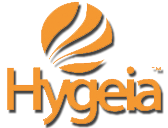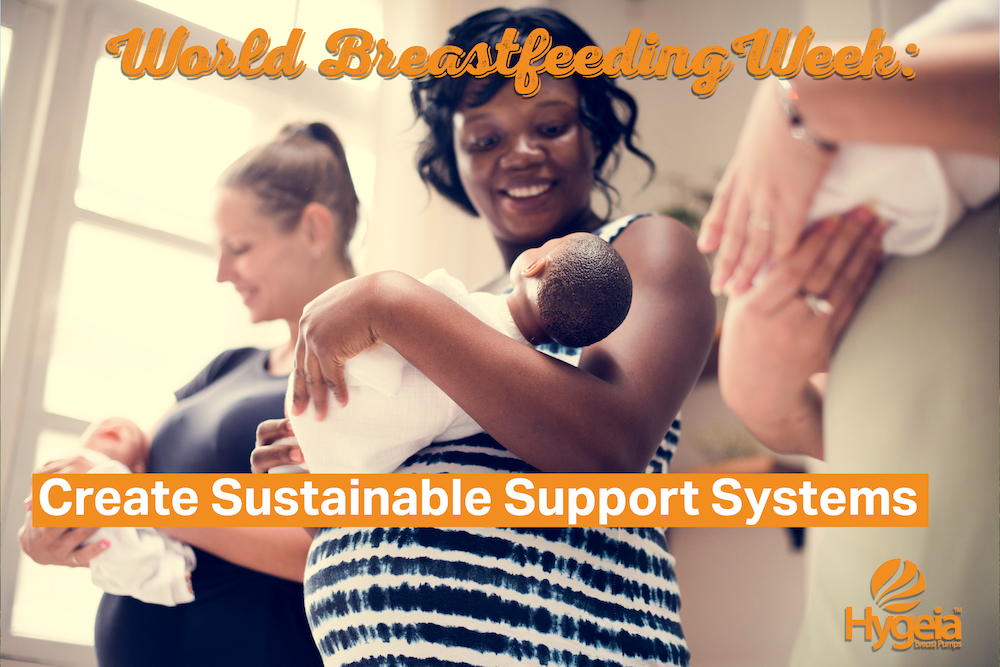
The most common word used to describe breastfeeding is “natural”. This act shared between mother and baby reflects the beauty found in the natural role of motherhood. “Natural” also reflects why breastfeeding needs prioritized in today’s world. Breastfeeding is a natural solution and therefore a sustainable one. World Breastfeeding Week 2025 inspires us to look beyond the immediate act of feeding and consider a much bigger picture. This blog post will dive into the this year’s theme: “Prioritize Breastfeeding: Create sustainable support systems.”
The Environmental Toll of Artificial Feeding
Hygeia is in full support of all mother’s and how they choose to feed their babies, be it breastfeeding or formula. Fed is best. No questions. This is truly the most important thing for every baby and that every mom knows what is best for her and her baby.
However, it is important to recognize that the environmental impact of artificial feeding is considerable. The entire process of formula production is energy-intensive and resource-heavy. From sourcing ingredients to manufacturing, packaging, and global distribution, it is a far cry from a “natural renewable food” like breast milk. One one hand, breast milk is environmentally safe and produced and delivered to the consumer without pollution, packaging, or waste. Artificial milk options demand significant amounts of electricity, fuel for transportation, and water for processing and cleaning. The waste generated, from non-recyclable containers to discarded formula, places a heavy burden on our planet’s ecosystems.
Building Sustainable Support Systems
Recognizing breastfeeding’s vital role in a sustainable future isn’t enough. We must create robust and sustainable support systems for families. There are numerous ways this can be done.
- Community Support: Grass roots is where all things begin. Fostering networks of lactation consultants, peer support groups, and family encouragement are necessary for normalizing breastfeeding. At Hygeia, we offer lactation support in partnership with Nest Collaborative. These virtual breastfeeding consults are accessible anytime, anywhere, and covered by most insurance plans.
- Workplace Policies: For breastfeeding to be normalized there must be support in the workplace. This will happen through advocacy for comprehensive paid maternity leave and flexible work arrangements. Additionally, moms need dedicated breastfeeding-friendly environments with clean, private lactation spaces.
- Healthcare System: The support and education must begin from day one for mothers. We must ensure that healthcare providers are well-trained in lactation support. Facilities must also adhere to best practices like the Baby-Friendly Hospital Initiative.
- Policy and Advocacy: Globally, we must endorse policies that protect, promote, and support breastfeeding. This includes strict adherence to the International Code of Marketing of Breast-milk Substitutes to counter misleading marketing.
- Changing the Narrative: All of these steps will play a part, but individuals must also work to normalize breastfeeding in all settings. Encourage a mom who is breastfeeding in public. Educate a friend on her public breastfeeding rights. Help dismantle any lingering stigma around breastfeeding.
Breastfeed
At Hygeia, we believe that empowering mothers is the first step toward a more sustainable future. By providing you with access to our high-quality breast pumps, we aim to make breastfeeding a comfortable and efficient experience. Every journey is unique, which is why we’re dedicated to helping you get your pump 100% covered by your insurance plan. We are removing financial barriers to this natural choice.
Supporting a mother is an act of environmental stewardship. By strengthening the systems around us—from our communities to our workplaces—we can make breastfeeding a realistic option for more families. It’s an investment in a healthier tomorrow, for our children and for our planet. Therefore, join us in championing this natural, sustainable solution during World Breastfeeding Week.
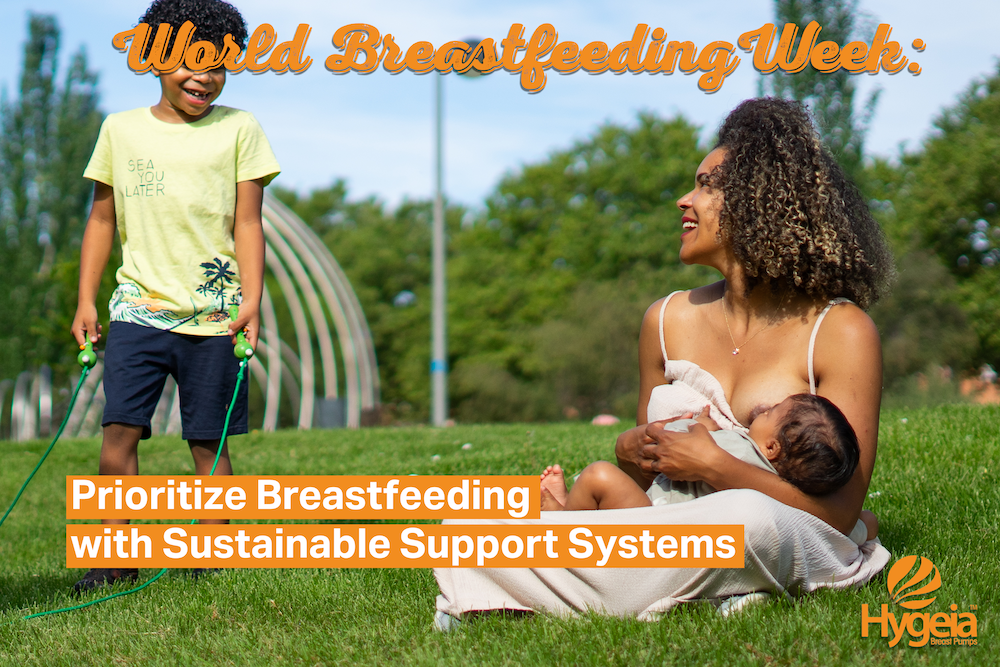
Imagine a single act that nourishes a baby, empowers a mother, and protects our planet. This World Breastfeeding Week 2025, we’re doing more than celebrating infant feeding; we’re championing a powerful solution for our planet’s future. From August 1st to 7th, the #WBW2025 campaign will shine a crucial spotlight on the profound connection between breastfeeding, environment, and climate change, urging all to “Prioritize Breastfeeding: Create Sustainable Support Systems.”
The world is in the trenches of era where environmental concerns dominate global conversations. Hygeia will always support mothers in finding the best solution for their personal situation and seeing to it that baby is fed and mother is healthy. However, at Hygeia, we also know it is vital to recognize breastfeeding as a key player in fostering a sustainable environment and actively reducing the impact of climate change caused by artificial feeding.
The Green Power of Breastfeeding
Breast milk is often called nature’s perfect food, but its environmental benefits are equally remarkable.
Reduced Carbon Footprint
Unlike infant formula, breastfeeding boasts a significantly lower carbon footprint. It requires no industrial manufacturing processes, factories, or energy-intensive machinery that release greenhouse gas emissions. Furthermore, breast milk is the ultimate local food; it requires no transportation, eliminating the emissions associated with shipping ingredients or finished products across vast distances.
Waste Reduction
Breastfeeding is a champion of waste reduction. It produces absolutely zero waste – no plastic bottles, no metal cans, no paper packaging to end up in landfills. Breastfeeding also significantly reduces water consumption. There’s no need for water to prepare formula or sterilize bottles, conserving this precious resource. While a breastfeeding mother needs to stay hydrated, this is a natural biological need, not an industrial demand.
Conservation of Resources
Breastfeeding lessens our reliance on industrial agriculture, particularly the dairy industry. Most formulas are cow’s milk-based, an industry known for its contribution to methane emissions from livestock, extensive land degradation for grazing, and massive water usage. By choosing breastfeeding, we indirectly support resource conservation and the protection of biodiversity, promoting more sustainable practices overall.
Championing the Natural Solution
This World Breastfeeding Week 2025, let’s come together to champion this incredible, natural solution. At Hygeia Health, we are dedicated to empowering mothers through high-quality breast pumps and comprehensive support. Our products are designed to make breastfeeding more comfortable and efficient, while our resources provide valuable information and guidance.
By prioritizing breastfeeding and building strong, lasting support systems, we’re not just investing in the health and well-being of our children; we’re taking meaningful climate action and fostering a truly sustainable environment for future generations. Every ounce of breast milk is a drop in the ocean of positive change.
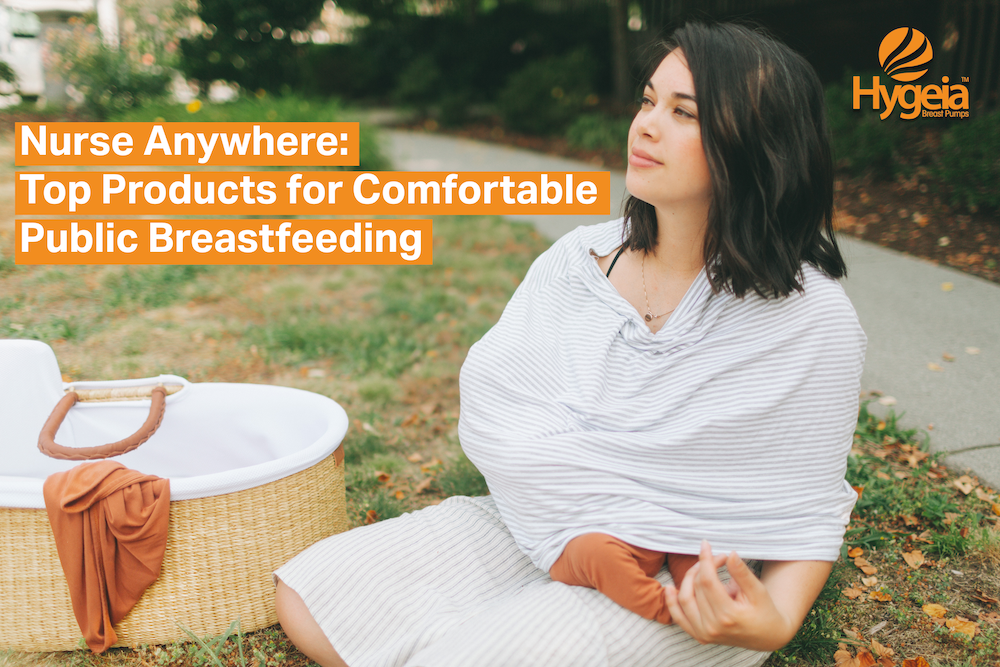
Breastfeeding in public is a powerful and natural act–let’s get that fact out in the open from the start. It allows you to nourish your baby whenever and wherever they need it. Because of this, no mom should ever feel that other people’s comfort should trump their baby’s need to eat. However, it’s also important to not judge each other as breastfeeding mothers. While you may not think twice about breastfeeding in a crowded restaurant, a first-time mom who is the first of her friends or family to breastfeed may not share your confidence
That confidence often comes with practice and early in the journey having the right tools can make a big difference. This blog covers the products meant to help create comfort, discretion, and convenience, empowering any mom to breastfeed anywhere.
Essential Apparel for Public Nursing
Choosing the right clothing can simplify public breastfeeding immensely.
Nursing Bras: A good nursing bra offers easy, one-handed access. Look for options with simple clasps or pull-aside designs. They provide necessary support while making feeding quick and discreet. Many brands offer comfortable, wire-free styles perfect for everyday wear.
What to choose? Check out this list of best nursing bras in 2025 from BabyList.
Nursing Tops: These tops feature hidden openings, lift-up panels, or crossover designs. They allow you to nurse without exposing your midsection or needing to lift your entire shirt. Pairing a nursing top with a cardigan or jacket can add another layer of discretion.
What to choose? Here’s a list of 30 of the best nursing tops in 2025 from MomLovesBest.
Layered Clothing: This simple strategy is often the most effective. Wear a loose top over a tank top. When it’s time to feed, lift the outer shirt and pull down the tank top. This creates a natural cover around your midsection while keeping you comfortable.
What to choose? Try these nursing tanks recommended by Mom Junction.
Covers and Privacy Tools
While not every mom chooses to use one, nursing covers can offer extra privacy. Some baby’s even come to prefer the cover!
Traditional Nursing Covers: These are often apron-style or poncho-style fabrics that drape over you and your baby. They come in various patterns and materials. Some have a rigid neckline that allows you to maintain eye contact with your baby.
Check it out: The Kids N’ Such Nursing Cover with a built in burp cloth.
Multi-Use Covers: Many popular covers double as car seat covers, shopping cart covers, or even scarves. This versatility makes them a smart investment for busy moms. They are lightweight and easy to pack.
Check it out: These top picks are extremely versatile and well loved.
Light Blankets or Swaddles: A simple, lightweight blanket or muslin swaddle can serve as an impromptu nursing cover. They are breathable and typically something you already carry for your baby.
Check it out: The Aden+Anais Muslin Swaddle Blankets are a long-time favorite.
Beyond the Products: Confidence and Rights
Remember, you have the legal right to breastfeed in public in all 50 U.S. states. The best product for public breastfeeding is often your own confidence. The tools listed in this blog simply offer practical ways to feel more comfortable and empowered as you nourish your baby, no matter where you are.
Use this guide to be well versed in your state’s public breastfeeding laws and how your rights are protected.
Pumping in Public
You also have every right to pump in public. The Hygeia Express is dependable for quick, quiet pumping when you need to relieve engorgement or express any amount of milk. With it’s collection cups the Hygeia Express even functions as a hands-free pump. By fitting inside your bra, it allows for completely hands-free and discreet milk expression. Weighing less than a pound, it is ideal for multitasking or pumping on the go without drawing attention due to it’s whisper quiet technology.
At Hygeia Health, we champion every breastfeeding mom. We understand the importance of reliable tools that integrate into your active life. We believe access to a quality pump is a right, not a privilege. Did you know that many insurance plans cover the cost of a breast pump? Hygeia Health specializes in helping moms navigate this process to get a 100% insurance-covered breast pump.
Ready to enhance your breastfeeding confidence with a high-quality pump designed for your active life? Apply today to see if you qualify for a free Hygeia Health breast pump.
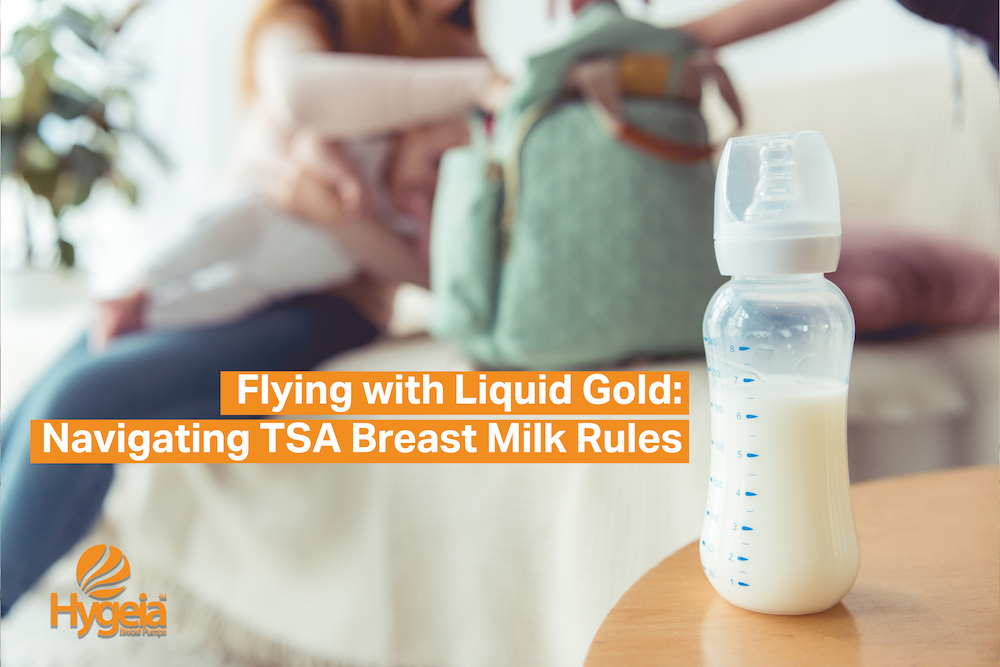
Vacation time has arrived! You’d be psyched if you weren’t stressing about what unexpected hiccups traveling with a baby may bring. One common concern is how to manage breast milk and breast pumps through airport security. The good news is, the Transportation Security Administration (TSA) has specific, clear rules designed to support parents. Understanding these TSA breast milk rules can help ease your travel worries and ensure your breastfeeding journey continues smoothly, even on the go.
TSA Breast Milk Rules: The Essentials
To give you some immediate relief, know that a mama’s breastmilk rules are different from the everyday passenger. When you’re flying with breast milk, it’s important to know the key regulations.
Exempt from the 3-1-1 Rule: Unlike other liquids, breast milk (and formula, and juice for infants) is exempt from the 3-1-1 rule for carry-on luggage. This means there is no quantity limit for how much milk you can bring. You heard that right: you can bring as much as you need.
The 3-1-1 Rule states a carry on bag is limited to 3.4oz (100mL) of liquid (3) in one (1) transparent quart size bag per passenger (1). But, reiterate, this does NOT apply to you, breastfeeding mama! You can carry breast milk in quantities greater than 3.4 ounces in your carry-on bag and it does not need to fit into a quart-sized bag.
Form of Milk: The rules–or lack of the 3-1-1 rule–applies whether your breast milk is fresh, frozen, or partially thawed. Just be prepared for them to be screened separately.
Note that it is possible that TSA will also require partially thawed breast milk for testing. It’s not common and just depends on the airport. They could require enough liquid to use a sanitary test strip to test it.
Cooling Aids Allowed: Ice packs, freezer packs, and frozen gel packs are permitted in carry-on bags to keep your breast milk cool, even if they are partially melted. These are also exempt from the 3-1-1 rule as well.
Declaration is Key: Always declare that you are carrying breast milk (and associated cooling aids) to a TSA officer at the start of the screening process. This helps them guide you through the correct procedure where these things can be screened separately.
Screening Process: Your breast milk will be screened, but you can request that your milk not be x-rayed. If you opt out of x-ray screening, the TSA officer will likely perform additional screening, which may include opening the containers or a separate search. You have the right to refuse the opening of sealed containers if you are concerned about contamination. In such cases, alternative screening procedures will be offered. Don’t stress it too much; TSA officers are trained to accommodate breastfeeding parents.
Why These Rules Matter for Breastfeeding Moms
These relaxed TSA breast milk rules are vital for mothers. They allow you to maintain your milk supply by keeping to your pumping schedule while traveling. This flexibility ensures your baby receives their essential nutrition without interruption, whether you’re traveling with them or pumping while away. It reduces stress, making air travel a less daunting experience for breastfeeding moms.
Traveling with Your Breast Pump
Good news! Your breast pump is considered a medical device by the TSA. Here is what this means:
Carry-On or Checked: You can bring your breast pump as a carry-on item in addition to your personal bag, or you can check it. Many moms prefer to carry it on to avoid potential damage or loss.
No Special Screening: Your breast pump will go through standard x-ray screening like other electronics.
Simplify Your Travel with the Right Pump
A high-quality breast pump designed for portability can make all the difference when flying. Choosing a pump that is efficient and easy to clean aligns perfectly with the demands of airport security and busy travel days.
At Hygeia Health, we understand the unique needs of breastfeeding moms on the go. Our high-quality breast pump, the Hygeia Express, is built for reliability and ease of use, making it an excellent choice for travel.
Did you know that many insurance plans cover the cost of a breast pump? Hygeia Health specializes in helping moms navigate this process to get a 100% insurance-covered breast pump. Ready to travel with confidence, knowing your milk supply is supported? Apply today to see if you qualify for the Hygeia Express and make your next flight a breeze.
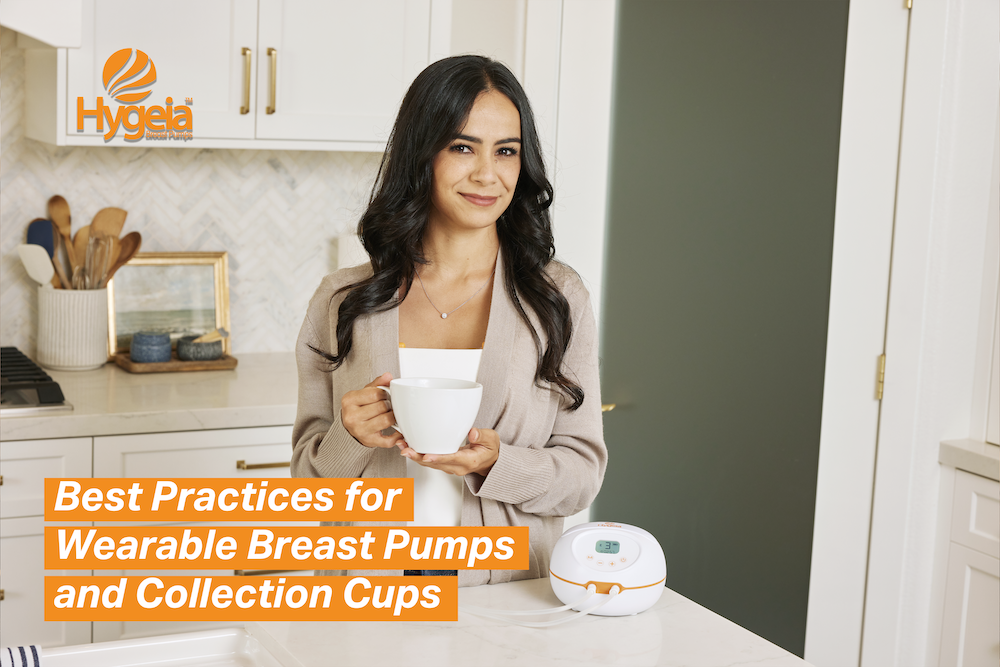
Life with a newborn moves fast and before you know it, a work schedule beckons. Many moms want to continue providing breast milk for their babies past those first weeks of infancy, but traditional pumping can tie them down or be too all-consuming to fit into the schedule. This is where wearable breast pumps and collection cups come in. These innovative tools offer incredible freedom, letting you pump discreetly while you tackle chores, work, or simply enjoy hands-free moments. But to get the most out of them, knowing a few best practices for wearable breast pumps helps.
Understanding Wearable Technology
Wearable breast pumps are small, motor-driven pumps that fit inside your bra. They collect milk directly into a cup, freeing you from bottles and tubes hanging from your chest.
Collection cups, on the other hand, are designed to fit with a traditional pump’s motor, replacing the standard bottles to offer a more discreet, in-bra pumping experience.
Both aim to make pumping on the go easier and more integrated into your daily life.
Choosing the Right Fit: Flange Sizing Matters
Just like with any breast pump, flange size is critical for comfort and efficient milk expression with wearable pumps and collection cups. A flange that’s too small or too large can lead to discomfort, pain, and reduced milk output.
How to Check: After a few minutes of pumping, look at your nipple. It should move freely in the tunnel without too much of the areola being pulled in.
Signs of Poor Fit: Pain, redness, nipple blanching (turning white), or feeling like you’re not fully emptying your breast
Solution: Many brands offer various flange sizes. If you’re unsure, consult a lactation consultant for a proper fitting. Getting this right prevents pain and maximizes your milk production. In some cases moms can do best without inserts in their wearables.
Maximizing Your Wearable Pumping Sessions
Even with the convenience of wearable pumps, technique still matters for a good milk yield. Additionally, using only this hands-free technology for pumping isn’t recommended by many experts.
Reserve Wearable Pumping Time: Use your wearable pump and collection cups only a few times a day if you are exclusively pumping or semi-exclusively pumping. Choose the circumstances or times when it is most helpful, like car rides or when juggling kid demands.
Plan for Longer Pump Sessions: Pump until your breasts feel empty or milk flow significantly slows. This might vary from session to session, but many moms need to pump longer (often 10+ minutes more than usual) to get the same level of stimulation and milk.
Standard Prep and Set Up Matters: Keep to your regular best practices for pumping. A gentle breast massage or warm compress before you start can help with milk let-down. Be sure to have water close at hand and stay hydrated.
Proper Placement: Ensure the collection cup or wearable pump is positioned correctly against your breast, forming a good seal. This prevents leaks and ensures efficient suction.
Cycle and Suction Settings: Experiment with the settings. Start with a faster, lighter suction to encourage let-down, then switch to a slower, deeper suction cycle for milk expression. Adjust suction to a comfortable level. You should never feel pain.
Cleaning and Maintenance for Longevity
Maintaining hygiene is crucial for any breast pump, especially wearable pumps and collection cups that touch your skin and milk directly.
Wash After Each Use: Disassemble all parts that come into contact with milk. Wash them immediately with warm, soapy water and rinse thoroughly.
Sterilize Regularly: Sterilize parts according to manufacturer instructions, usually daily or every few days, especially for newborns.
Air Dry Completely: Allow all parts to air dry completely on a clean paper towel or drying rack to prevent bacterial growth.
Check for Wear and Tear: Regularly inspect silicone parts for rips or cracks, as these can affect suction and hygiene. Replace them as needed.
Embrace the Freedom You Deserve with Hygeia Health
Wearable breast pumps and collection cups are game-changers for active moms, offering flexibility and discreetness. By following these best practices, you can ensure comfortable, efficient milk expression and maintain your milk supply.
At Hygeia Health, we understand the demands of modern motherhood. We are committed to providing high-quality breast pumps that support your unique breastfeeding journey. Did you know that many insurance plans cover the cost of a breast pump? Hygeia Health specializes in helping moms like you navigate this process to get a 100% insurance-covered breast pump.
Ready to experience the freedom of efficient, discreet pumping? Apply here to see if you qualify for a 100% insurance-covered breast pump and make your breastfeeding journey smoother.

